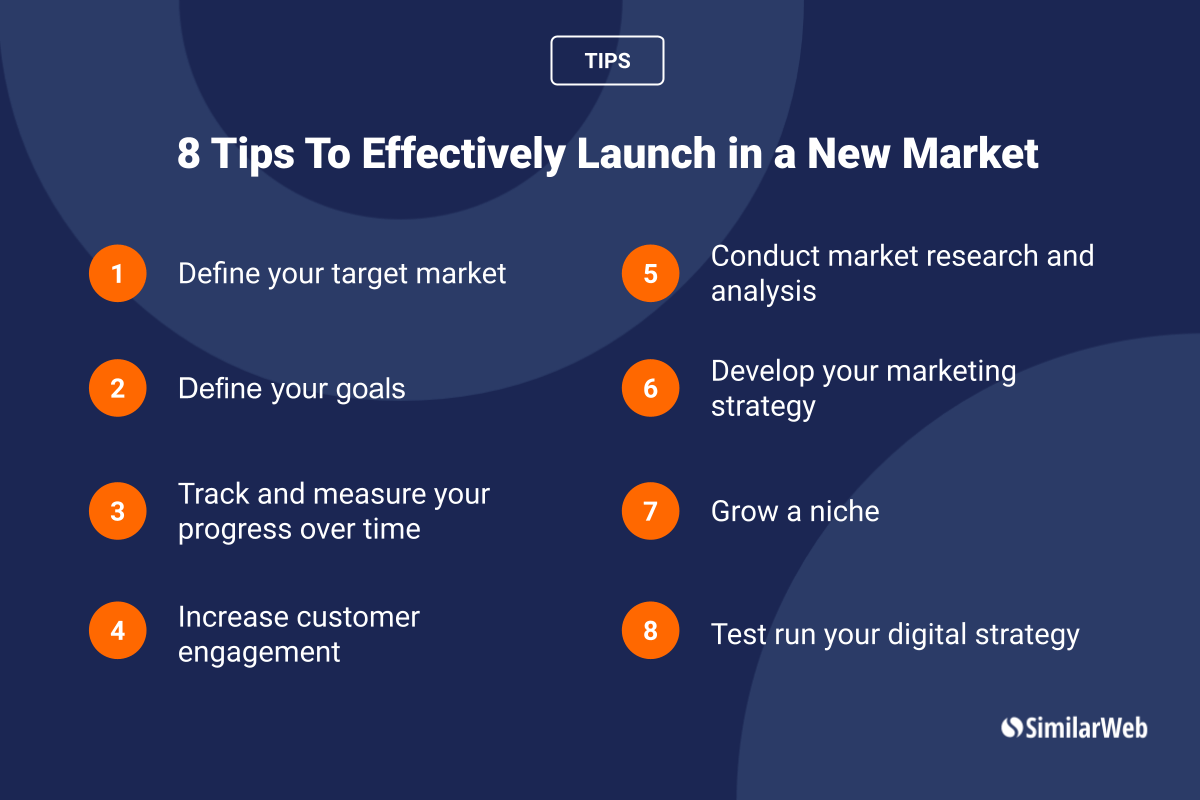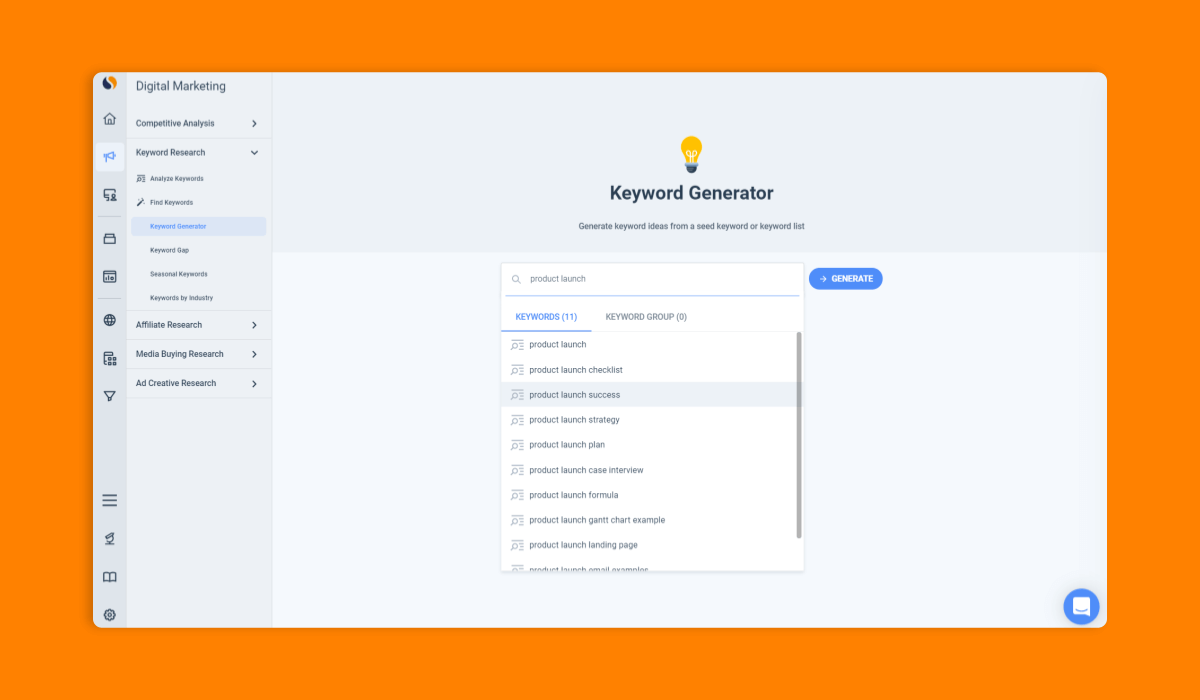8 Tips to Optimize Your New Product Launch in a New Market

Are you running a startup or getting ready for a new product launch and feeling afraid to fail? You have good reason to be concerned. According to Harvard Business Review, 75% of product launches fail to entice consumers.
Visibility into potential profits and revenues and the ability to perform market research for your business plan with data analysis can be crucial for securing additional funding or scaling your business. To help, we’ve come up with eight tips for you to maximize your odds of successfully launching a new product in a new market. These same tips can be used when launching a new service or brand.
How to launch a new product in a new market
When you work to expand your market size, you should keep in mind that there are always risks involved, including the possibility of incurring heavy losses and even layoffs.
Data-driven decision-making is the number one way to avoid the pitfalls of launching in a new market and improving your brand’s online visibility.
1. Define your target market
Entering a new market requires creating a long-term strategy that clearly defines goals and outlines milestones for your new product launch. What are the main user demographics of your target market? Are they mobile-first or social-savvy? When and where do they shop online? What is their age distribution?
Answering these questions about demographics and potential customers is a vital step in order for you to present your product in a way that makes sense to your target market whether it’s in your marketing plan or in your design.
Your starting point is to calculate your serviceable obtainable market (SOM) and, based on that, prepare a list of primary user personas. A user persona is a fictional character created to represent a customer type that might use a product or service based on their use case and how it can solve an existing problem. For more on how to create user personas, check out this blog post by Hotjar.
Target market example: Young adults aged 20- 30, who live in the United Kingdom and are potential students or new parents. They’re very keen on online shopping and, on average, spend 1,000 hours and 2,500 British pounds a year online.
Questions to ask about your target audience before your new product launch
Defining your market is one thing, getting the right people to act is another ball game. These questions will help you focus and refine your strategy.
- Which action do you want your target audience to take?
- Who are the people most likely to take the specific action and use your new product? (get specific about demographics: age, gender, location, device, etc.)
- What are their pain points that you can address with your product?
- What is the solution your product offers for these issues?
- Which comparable products does your target audience currently use?
- How much does it cost them to use the competitor’s product?
- Which communication channels do they use most frequently?
- How and when are they most likely to purchase your product (is it seasonal, time-sensitive, one-time, or recurring; will they purchase online or offline, cash or card, etc.)?
- Which communication channels would they prefer for feedback and support?
- What can you offer as an incentive? What would be most attractive for your target audience in relation to your product (a discount, demo, free trial)?
The next critical step is to figure out the best way to reach the specific audience you are targeting.
Ways to reach your audience
Answering the ten questions above puts you on the right track. You’ve assessed which channels your audience uses and how they prefer to communicate.
If you are already marketing to a similar audience, identify your most effective channels by analyzing your existing audience’s behavior. Check performance metrics, such as top referring domains, social media networks and affiliates, views and conversions, email open and click-through rates, and engagement metrics.
Next, you need to determine how to leverage what you know about your target audience’s behavior for your new product launch.
Imagine the purchasing funnel and how you will gently guide your potential customers through. You will need to prepare different content types for different funnel stages and distribute them on various channels.
Consider the funnel
Typically, your initial effort will focus on raising awareness for something new. You want to determine the best tactics that let you create a buzz. Social Media, blogs, native advertising, infographics, other visual content, and video clips are handy for the top of the funnel (TOFU). Large brands often start building up the anticipation level before the launch date.
In the middle of the funnel (MOFU), which is the consideration stage, you need to start engaging and presenting your product features more clearly. When people evaluate your product and consider a purchase, useful channels are podcasts, webinars, free guides, e-books, reports, and reviews. You can use PPC and display ads to promote some of your high-value content.
The final step towards deciding is usually the hardest for the prospect. At the bottom of the funnel (BOFU) you want to help them take the final step by finding ways to engage so you can address individual pain points. Use email marketing to distribute gated content that lets you collect leads. White Papers, comparisons, reports, and product presentations can provide the audience with the needed input.
Another approach could be to offer live events, workshops, and conferences, or you could do a raffle, a contest, or another challenge on social media. Get more ideas about how to get started with your content marketing and which content is best for each funnel stage.
2. Define your goals
Goal setting adds clarity and is an essential part of any successful product launch strategy. There are a number of goals that are commonly found in relation to launching in a new market:
Financial goals
If you want to set revenue goals, ask yourself: how many product units will I need to sell in order to cover my production and marketing costs? When do I expect to reach profitability? How much income can I generate in a month/quarter/year?
Financial goal examples: Add $1 million in incremental revenue over a year; increase profit margins by 10%; boost customer retention or renewals rates; increase profit margins by 10%.
Customer goals
Are you releasing a new product in the market (even an add-on or premium feature) to an existing customer base or a tried-and-tested product to a new market? You need to understand who your customers are in order to anticipate the likelihood they’ll purchase the product – and determine your customer goals accordingly.
Customer goal examples: Sell a premium product to 1,000 highly engaged new customers; release and sell 100 units of a top-performing product in a new country.
Brand awareness goals
Creating a branding strategy is an important step in creating hype around any new product launch. Make sure you understand the various stages of your product’s positioning and then translate that into clear marketing objectives within your marketing strategy. It’s also vital to measure your brand awareness and track progress over time so you can evaluate and optimize your strategy on a regular basis.
Brand awareness goal examples: Increase organic website traffic by 20%; become a go-to resource for information about the topic your product is addressing by doubling the share of traffic for high-intent keywords; add 2,000 social media followers through relevant influencers and online communities.
3. Track and measure your progress over time
From the very beginning of your new product launch, make it a routine to track and review your key performance metrics. Use that information to tailor your offering to both your prospects’ and your customers’ needs. You can use an online tracking tool such as Google Analytics to gain an overall understanding of traffic behavior on your site. Metrics to look out for include: Sessions, Bounce Rate, Average Session Duration, Traffic Channels, and Conversion Rate.
4. Increase customer engagement
Whether big or small, all companies should seek out and implement ideas for increasing customer engagement. Engaged customers deliver 23% more revenue than average and are generally more loyal, making them less likely to switch to rival brands.
Here are a few things that can help you increase your customer engagement:
- Live chat: Adding a human factor (or bot) to your website, which offers real-time support, helps your visitors when they need you the most. Intercom is a live chat software that lets you easily connect with prospects and clients, improving their customer experience.
- Free trial: Sites that offer a time-limited free trial (giving users a taste of the product or service) are more likely to convert those users into paying customers.
- In-app and push messaging: With in-app and push messaging, you can deliver customized information to customers when they’re active. OneSignal and Google’s Firebase are two popular services that offer in-app notifications.
- Customer feedback: Proactively collect information shared by your community about their overall experiences with your company, product, or services. You can do this by using customer satisfaction surveys or market research questionnaires.
5. Conduct market research and analysis
Market research is never easy to do. There are plenty of factors and considerations to keep in mind when looking at your target market. Everything from customers’ wants and needs and your product’s unique value proposition to your competitors’ strengths and weaknesses. Capabilities relevant for market research include:
- Competitor Analysis: Uncovering your competitors’ online performance and market strategies.
- Keyword Research: Revealing organic and paid keywords that are prominent in your target market, as well as their traffic share and level of competition, in order to develop an international SEO strategy.
- Competitive Benchmarking: Understanding the target market’s attractiveness by comparing your website against a number of key competitors.
Download Your Free Product Launch Templates
Similarweb’s competitive intelligence platform offers actionable insights to help you understand, track, and grow your digital market share and launch in new target markets. Try Similarweb Platform now for free!
6. Develop your marketing strategy
How you want to approach launching a new product in a new market depends on your long-term marketing strategy. To develop an effective launch strategy that is synchronized with your long-term objectives, identify your strategic challenges and opportunities so that you can define a set of marketing objectives to scale your business. Your marketing strategy should include a combination of multiple marketing channels – ranging from paid search to referrals and social media – based on your product, target audience, and competitors’ marketing strategies.
Your starting point here is to evaluate your direct competitors’ websites and the digital benchmarks in your industry. How is their email marketing working? Have they made any changes lately that have resulted in a higher conversion rate?
Then you can identify which marketing channels are underused by competitors and devise a plan to take advantage of the holes in their digital strategies.
For example, say you notice your competitors are not spending any money on referrals. You might decide to create an affiliate marketing program by reaching out to the most visited websites in several categories – review sites, bloggers, and influencers in the market you want to enter and create exclusive referral contracts in which these sites send traffic to your website based on monthly commission payouts.
7. Grow a niche
Having a product that has a unique benefit is just one way to differentiate yourself from others. Another great way is to tap into a niche market within a larger market that is being overlooked or unchallenged — for instance, selling electric toothbrushes that are designed especially for elderly people or offering an online delivery service for the deaf. The key here is to pinpoint your target audience and seek out as many ways as possible to let them know why your service is a fit for their specific pain points.
You can use Similarweb to do this as well. Simply look for similar websites or ideas using the Keyword Generator Tool, which provides hundreds of keyword suggestions that let you uncover the traffic volume and search intent for any topic or search query.
8. Test run your digital strategy
When you ask yourself how to launch a new product in a new market, remember, the only thing worse than not trying is rushing. Start with baby steps by exploring a product’s acceptance in a small segment of your market in order to obtain a measure of its sales performance. You can test everything from landing pages to email campaigns to early-bird discounts. Optimizely and Unbounce offer easy-to-use testing tools that let you run experiments between multiple landing pages and find out where your conversions are coming from.
Getting started
See how Similarweb can help you improve your business strategy, try Similarweb platform for free now.
Track your digital metrics and grow market share
Contact us to set up a call with a market research specialist














